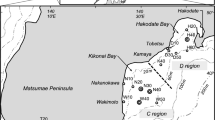Abstract
Although amphioxus is widespread in temperate and tropical seas, its population is diminishing because of environmental pollution. To keep the population of this evolutionarily important animal from diminishing, study on its reproduction and development is necessary. The main findings in this study on the spawning and fecundity of the amphioxus reared in laboratory and its larval development are as follows. 1. Water temperature markedly affected the spawning. It spawned only when water temperature reached 21°C. 2. Spawning of the amphioxus in laboratory was markedly extended. Initially, the amphioxus spawned at about 7:00 PM, but spawning time was postponed as spawning days went on. 3. The number of eggs produced by a female ranged from 1400 to 12800, average of 5800. This also represents the fecundity of the amphioxus because it shedded all eggs within the ovary at a time. 4. During the first few months of life of the amphioxus, its growth rate changed seasonally. The growth rate in summer and fall was greater than that in winter. 5. The pelagic larva became a benthic adult after 50 days. 6. The amphioxus reared in laboratory from fertilized eggs could produce fertile eggs and sperms. These findings can be a foundation for measures to address the problem of diminishing amphioxus population.
Similar content being viewed by others
References
Carroll, R. L., 1988. Vertebrate Paleontology and Evolution. W. H. Freeman and Company, New York, pp. 16–25.
Courtney, W. A. M., 1975. The temperature relationships and age structure of North Sea and Mediterranean populations of Branchiostoma lanceolatum.In: “Protochordates” (E. J. W. Barrington and R. P. S. Jefferies, Eds.). Academic Press, New York pp. 213–233.
Fang, Y. Q., Zhao, W. X. and Wei, H., 1993. Correlation between steroid hormones and gonodal development in amphioxusBranchiostoma belcheri Gray.Chin. Sci. Bull. 38: 744–746. (in Chinese)
Fang, Y. Q., 1987. Ecological habits and protection of amphioxus,Chin. J. Zool. 22(2): 41–45 (in Chinese)
Flood, P. R., 1975. Fine structure of the notochord of amphioxus.In: “Protochordates” (E. J. W. Barrington and R. P. S. Jefferies ed.). Academic Press, New York, pp. 81–104.
Guthrie, D. M., 1975. The physiology and structure of the nervous system of amphioxus (the Lancelet),Branchiostoma lanceolatum Pallas.In: “Protochordates” (E. J. W. Barrington and R. P. S. Jefferies, ed.), Academic Press, New York pp. 43–80.
Holland, L. Z. and Holland, N. D., 1992. Early development in the lancelet (=amphioxus)Branchiostoma floridae from sperm entry through pronuclear fusion: presence of vegetal pole plasm and lack of conspicuous ooplasmic segregation,Biol. Bull. 182: 77–96.
Jing, D. Q., 1958. Amphioxus. Fujian People's Publication Company, Fuzhou. (in Chinese)
Just, J. J., Kraus-Just, J. and Check, D. A., 1981. Survey of chordate metamorphosis.In: “Metamorphosis” (L. I. Gilbert and E. Frieden, ed.). Plenum Press, New York and London, pp. 265–326.
Shirai, H., 1992. Effect of light on spawning time in the amphioxus,Branchiostoma belcheri tsingtauense.Acta Anat. Nippon 67: 802.
Webb, J. E., 1975. The distribution of amphioxus.In: “Protochordates” (E. J. W. Barrington and R. P. S. Jefferies, ed.). Academic Press, pp. 179–212.
Welsch, U., 1975. The fine structure of the pharynx, cyrtopocytes and digestive caecum of amphioxus (Branchiostoma lanceolatum).In: “Protochordates” (E. J. W. Barrington and R. P. S. Jefferies, ed.). Academic Press, pp. 17–41.
Wickstead, J. H., 1975. Acrania (Cephalochordata).In: “Reproduction of Marine Invertebrates, Vol. II” (A. C. Giese and J. S. Pearse, ed.). Academic Press, New York, pp. 283–31.
Wu, S. C., 1985. The early differentiation of amphioxus.Adv. Sci. China Biol. 1: 231–266.
Author information
Authors and Affiliations
Additional information
Contribution No. 2274 from the Institute of Oceanology, Chinese Academy of Sciences
This work was supported by CNNSF, and Chinese Academy of Sciences.
Rights and permissions
About this article
Cite this article
Xian-han, W., Shi-cui, Z., Yong-yuan, W. et al. Laboratory observation on spawning, fecundity and larval development of amphioxus (Branchiostoma belcheri Tsingtaunese). Chin. J. Ocean. Limnol. 12, 289–294 (1994). https://doi.org/10.1007/BF02850488
Received:
Issue Date:
DOI: https://doi.org/10.1007/BF02850488




